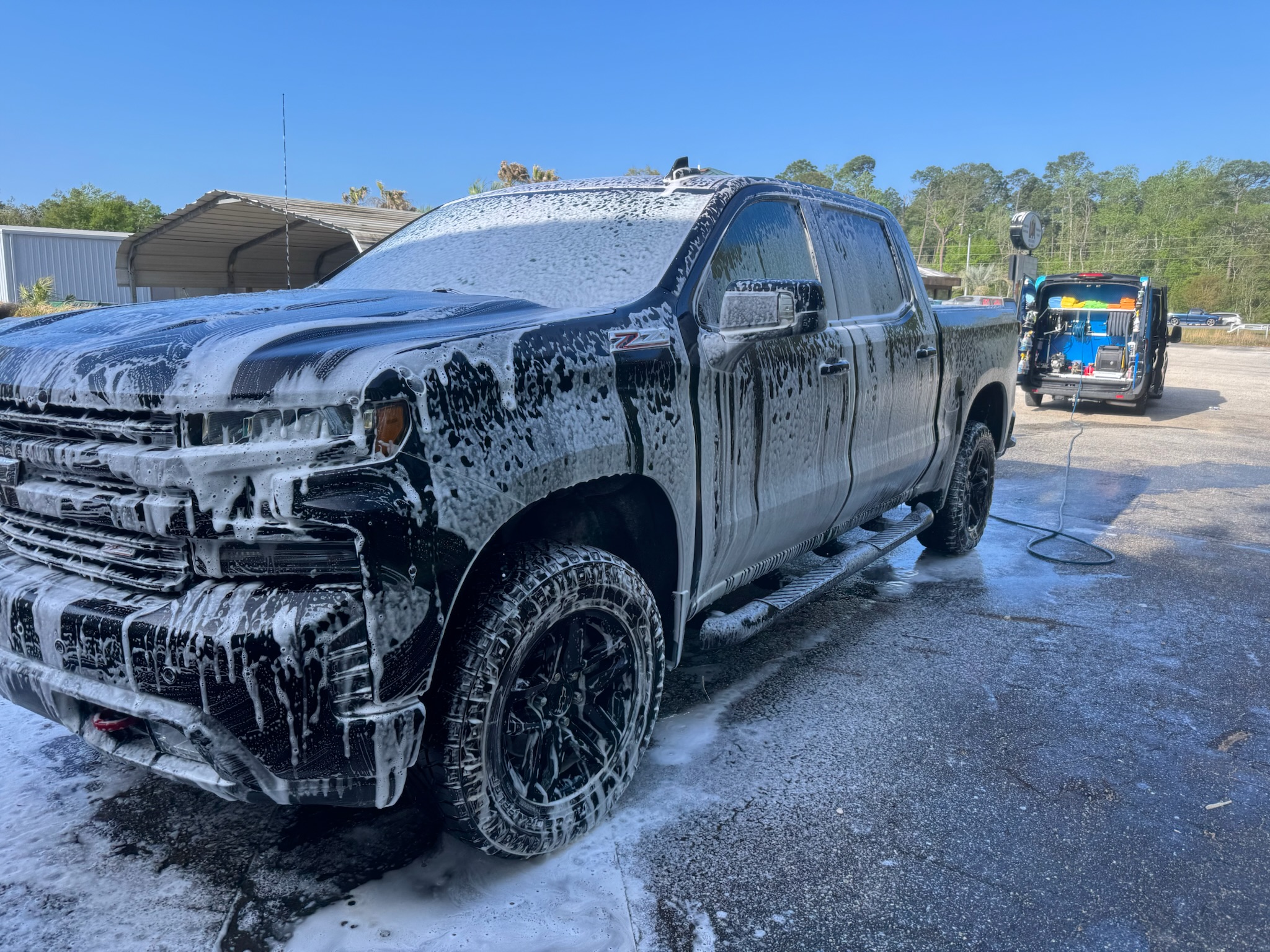Ace Mobile
Detailing

How Seasonal Changes Affect Your Car’s Exterior (and What Detailing Can Do About It)
Owning a car isn’t just about mobility—it’s about pride, investment, and presentation. One of the biggest threats to your vehicle’s appearance and longevity isn’t just how you drive it, but the environment it endures every day. Seasonal changes, from scorching summer sun to winter’s freezing moisture, quietly wreak havoc on your car’s exterior. And if you’re not paying attention, that wear and tear builds up fast. The good news? Regular professional detailing can be a game-changer in preserving your car’s condition year-round.
The Silent Damage of Seasonal Shifts
Each season introduces unique environmental factors that challenge your car’s paint, trim, and protective coatings. While these changes might not be immediately obvious, over time, they begin to dull the shine, break down protective barriers, and leave behind lasting marks. Detailing isn’t just about getting your car to look good for one afternoon. It’s about protecting it against these unseen, long-term threats and maintaining that showroom-level pride in your ride.
Spring: Pollen, Rain, and the Return of Road Grime
Spring brings with it a mix of fresh blooms, rainy days, and unfortunately—pollen. While pollen might seem harmless, when left on your vehicle, it becomes abrasive and acidic, especially after a light drizzle or morning dew. Combine that with spring showers kicking up road grime and your car’s exterior becomes a magnet for mess.
Even more challenging is the cycle of rain and sun. Rain spots, especially when combined with airborne contaminants like pollen or pollution, can leave etching marks in your clear coat. When the rainwater evaporates, minerals are left behind and over time, those water spots can become permanent. A professional detailer not only removes these particles with a safe wash technique but also applies a sealant or wax to prevent them from bonding in the future.
Summer: UV Rays and Oxidation
While summer is ideal for road trips and weekend cruises, it’s also brutal on your car’s finish. Prolonged sun exposure can fade your paint and oxidize the surface. This is especially noticeable on darker-colored cars, where the damage tends to be more visually striking. UV rays break down the paint’s molecules, causing it to lose depth and gloss. Trim pieces—especially those made from rubber or plastic—can also dry out, crack, or warp when exposed to extreme heat for long periods.
During the hottest months, parking your car under direct sunlight day after day can cook the paint and even weaken previously applied wax or ceramic coatings. But regular detailing, especially one that includes UV-protectant treatments, works as a barrier. These specialized products help your vehicle reflect harmful rays instead of absorbing them, reducing the risk of paint oxidation and sun damage.
Fall: Leaves, Sap, and Temperature Swings
Fall might feel like a reprieve from summer heat, but it introduces a different set of challenges. As trees shed their leaves, your car becomes a landing pad for more than just colorful foliage. Fallen leaves might seem harmless, but when they sit on your car, especially if they get damp, they release tannins—natural acids that can stain your paint.
Sap is another sticky fall problem. It’s tough to see, harder to remove, and if left alone, it can harden into a crust that etches into your clear coat. In addition, autumn’s cool nights and warm days create a cycle of condensation that promotes oxidation and rust on exposed metal.
Detailing your car before the peak of fall is a smart move. It ensures that any existing contaminants like sap or acidic residue from leaves are safely removed. Detailers also apply protective coatings that prevent fall debris from bonding with your paint, making clean-up easier and less damaging.
Winter: Road Salt, Ice, and Slush
Winter arguably causes the most aggressive damage to your vehicle’s exterior. Between road salt, freezing moisture, and dirty slush, your car takes a beating every time you drive. Salt, while necessary for safer roads, is extremely corrosive. It accelerates rusting and eats away at your undercarriage, wheel wells, and even your paint if left unchecked.
The freeze-thaw cycle adds insult to injury. Moisture that enters small cracks or chips in your paint can expand when frozen, worsening the damage and sometimes leading to peeling or bubbling. Snow and ice, especially when scraped off aggressively, can also scratch the surface or compromise protective coatings.
A winter detailing session, especially one that includes an undercarriage wash and protective sealant, becomes crucial. Detailers use specialized products designed to repel salt and grime, and they often include rust inhibitors for areas prone to corrosion. This level of care keeps your car safer during the harshest season and ensures that winter’s wrath doesn’t leave permanent marks.
The Role of Protective Coatings
Regardless of the season, one thing remains constant—protective coatings make a major difference. Wax, paint sealants, and ceramic coatings act as a shield against the elements. While each provides a different level of durability and shine, they all serve one primary purpose: to create a barrier between your car’s surface and environmental threats.
Wax is great for short-term protection and offers a glossy finish, but it wears off relatively quickly. Paint sealants are synthetic and tend to last longer, offering months of protection and resilience. Ceramic coatings, on the other hand, bond with your vehicle’s surface and offer long-lasting, sometimes even years-long, protection. These coatings resist water, repel contaminants, and offer strong UV defense, making them a favorite among detailing pros for year-round protection.
Why Professional Detailing Beats DIY
It’s tempting to grab a sponge, some soap, and give your car a quick wash in the driveway. And while that’s better than ignoring it completely, it doesn’t offer the same benefits as a full professional detailing. Detailers use pH-balanced products designed to safely lift contaminants without harming your paint. They use microfiber cloths that reduce the risk of swirl marks and incorporate techniques like clay bar treatments, machine polishing, and deep waxing.
More importantly, they know what your car needs depending on the season. A professional detail isn’t one-size-fits-all. It’s tailored to the current threats your vehicle faces, from salt and slush in the winter to UV rays in the summer. That seasonal awareness is what helps maintain your car’s value, appearance, and longevity.
Consistency is Key
Getting your car detailed once a year isn’t enough if you want long-term results. The real power of detailing lies in consistency. Think of it like skin care for your car—the more regularly it’s done, the less long-term damage you’ll need to reverse. When your car’s exterior is consistently protected and maintained, it holds its value better, turns more heads, and resists the inevitable wear and tear that comes with driving in all seasons.
Many car owners don’t realize how much weather impacts their vehicle’s appearance until it’s too late. But once you see how your paint gleams after a detail, or how water beads off instead of soaking in, you’ll start to understand why so many people invest in professional care.
Seasonal Detailing Isn’t Just Aesthetic—It’s Preventative
The benefits of seasonal detailing go well beyond looks. It helps prevent rust, paint failure, trim degradation, and more. It extends the life of your vehicle’s exterior surfaces, makes cleaning easier, and even improves visibility when paired with services like headlight restoration and windshield treatment.
If your car could talk, it would probably thank you for every detail appointment. Those visits aren’t vanity—they’re a form of preservation. The road is tough, and nature is relentless. But with the right care, your car can not only survive but shine.
Final Thoughts
No matter where you live, your car faces the elements every single day. The rain, the sun, the falling leaves, the road salt—it all leaves its mark. While you can’t control the seasons, you can control how your car responds to them. Detailing is more than just making your car pretty. It’s about protection, prevention, and pride of ownership. So whether it’s spring pollen or winter slush, a good detail can make all the difference.
Let each season come and go—but let your car look like it never noticed.
